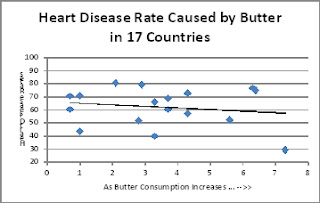Dairy Controversy? Here are the data
Check this out.
I did a very simple thing. I just looked at the heart disease rate in 17 countries (heart disease per 100,000 people).
Then, I found the average amount of dairy foods that these people are eating, per person, per year.
Below, you will see the graphs of three kinds of dairy products, and the full data set is down at the bottom of this post for:
Milk Products … Cheese … and Butter.
The question is this. Does more dairy consumption lead to more heart disease?
For the answer, on a population basis, check out these graphs. As consumption increases, what you see is that heart disease is either flat (does not increase), OR that it actually trends downward (is reduced). 
Maybe that’s because dairy products are associated with a reduction of the bad cholesterol, LDL.
This very simple assessment strongly argues against the idea that dairy is bad for your heart. By the way, if you compare dairy consumption with calcium supplementation (Here is the study), it’s the pills that increase the risk of myocardial infarction … not dairy.  And I am very well aware that this is a correlation only, and a causal link needs to be verified through double blind trials blah blah blah.
And I am very well aware that this is a correlation only, and a causal link needs to be verified through double blind trials blah blah blah.
But honestly, it’s really hard to argue against this kind of straightforward analysis, and say that increasing dairy leads to increasing heart disease rates.
| Country | Liquid Milk Drinks (Litres) | Cheeses (kg) | Butter (kg) | Heart Disease Rate |
| Sweden | 145.5 | 18.5 | 1 | 71 |
| Ireland | 129.8 | 10.5 | 2.9 | 79.2 |
| Netherlands | 122.9 | 20.4 | 3.3 | 39.8 |
| Norway | 116.7 | 16 | 4.3 | 57.2 |
| Spain (2005) | 119.1 | 9.6 | 1 | 43.5 |
| Switzerland | 112.5 | 22.2 | 5.6 | 52.2 |
| United Kingdom | 111.2 | 12.2 | 3.7 | 68.8 |
| Australia | 106.3 | 11.7 | 3.7 | 60.3 |
| Canada | 94.7 | 12.2 | 3.3 | 66.2 |
| Germany | 92.3 | 22.4 | 6.4 | 75 |
| France | 92.2 | 23.9 | 7.3 | 29.2 |
| New Zealand | 90 | 7.1 | 6.3 | 76.5 |
| United States | 83.9 | 16 | 2.1 | 80.5 |
| Austria | 80.2 | 18.8 | 4.3 | 72.7 |
| Greece | 69 | 28.9 | 0.7 | 60.3 |
| Argentina | 65.8 | 10.7 | 0.7 | 70.6 |
| Italy | 57.3 | 23.7 | 2.8 | 51.7 |

Looks like cheese consumption above 20kgs is more telling than other dairy. I'm assuming these countries eat different cheeses – which do you recommend?
Hi JB!!
Any, actually, as long as it is real, isn't colored DAY GLO or come out of an aerosol spray can.
So. Choose the cheese to your taste, and make sure the "high quality" is balanced by "low quantity" consumption.
Make sense?
Just read USA Weekend's "It's a man's world" article and they promote low-fat mil and yogurt per a Swedish study of more than 75000 adults over the course of 10 years. From what I have seen, low fat yogurt is terrible bc of all the sugars. Your thoughts?
There is also this study from the EJCN (www.nature.com/ejcn/journal/v64/n6/abs/ejcn201045a.html): Showing the HIGH FAT dairy … not LOW FAT dairy … leads to lower risk of cardiovascular disease. This is an Australian prospective study with a 15-year follow-up period, and very nicely done.
So. Science here, science there. How are you supposed to know what to do? In healthy cultures, they never ate modified food products, whether reduced fat diary or other processing methods.
And, the entire notion of modifying our food products at all is just an invention that we created only in the last 40 years.
My take? Just eat normal versions of food, in control, and you will be doing what healthy people do AND you will get their healthy results. Cool?